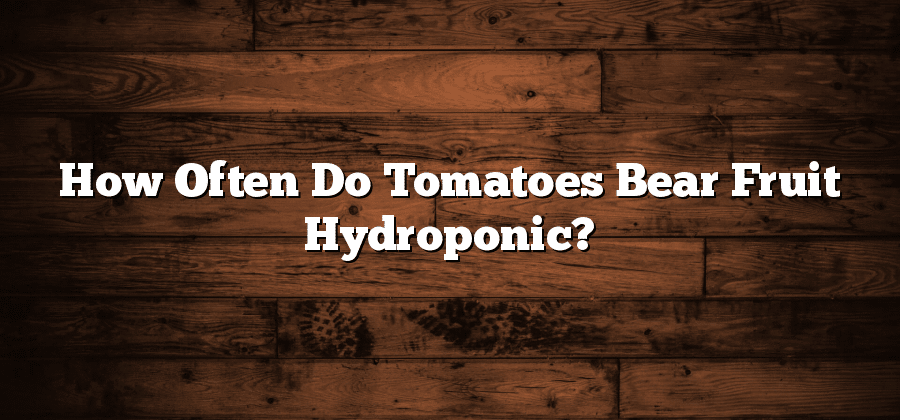Understanding Hydroponic Tomato Cultivation
Hydroponic tomato cultivation is a modern farming technique that involves growing tomato plants in a nutrient-rich water solution, without the use of soil. This method offers several advantages for tomato production, such as increased yield, reduced water usage, and the ability to grow tomatoes all year round. By eliminating soil as a medium, hydroponic systems provide better control over the tomato plant’s environment, allowing farmers to optimize conditions for growth and fruit production.
One of the key benefits of hydroponic tomato cultivation is the ability to provide plants with a precisely balanced nutrient solution. This ensures that tomatoes receive all the essential elements they need for healthy growth and high-quality fruit production. Additionally, by closely monitoring and adjusting nutrient levels, farmers can prevent nutrient deficiencies or excesses, which can negatively impact the plant’s growth and yield. To further enhance the success of hydroponic tomato cultivation, it is important to consider factors such as lighting, temperature, humidity, and CO2 levels, as these environmental conditions greatly influence the overall plant development and fruit production in hydroponics.
Factors Influencing Tomato Fruit Production in Hydroponics
Factors Influencing Tomato Fruit Production in Hydroponics
To achieve optimal tomato yield in hydroponics, it is crucial to understand the various factors that influence fruit production. One of the primary considerations is the choice of nutrient solution. Different tomato cultivars have varying nutrient requirements, and the nutrient solution formulation should align with these needs. Providing the correct balance of essential nutrients, such as nitrogen, phosphorus, potassium, and micronutrients, is vital for promoting healthy plant growth and maximizing fruit production. Additionally, maintaining proper pH levels in the nutrient solution is essential for ensuring nutrient availability and uptake by the tomato plants.
Another significant factor that affects tomato fruit production in hydroponics is the environmental conditions within the growing system. Temperature, humidity, and light intensity play crucial roles in the growth and development of tomato plants. Optimal temperature ranges, generally between 20°C to 25°C (68°F to 77°F), promote vegetative growth and flowering, leading to increased fruit set. Humidity levels should be controlled to avoid the onset of fungal diseases and promote proper transpiration. Furthermore, providing adequate and appropriate light intensity, either through natural sunlight or artificial lighting systems, is critical for facilitating photosynthesis and promoting fruit development.
Understanding these factors and their influence on tomato fruit production in hydroponics is essential for growers. By optimizing nutrient management and environmental conditions, growers can create an ideal environment for tomato plants to thrive and maximize their yield potential.
Optimal Environmental Conditions for Tomato Yield in Hydroponics
Tomatoes are a popular crop choice for hydroponic systems due to their high demand and potential for year-round production. However, achieving optimal yields requires careful attention to the environmental conditions within the growing environment. One key factor to consider is temperature. Tomatoes thrive in temperatures between 20 and 28 degrees Celsius during the day, with a slight drop to around 15 to 18 degrees Celsius at night. Maintaining consistent and ideal temperatures will help ensure proper growth and fruit development.
Another crucial environmental condition for maximizing tomato yield in hydroponics is humidity. While tomatoes prefer drier conditions compared to other crops, a relative humidity of around 60-70% is considered ideal. High humidity can lead to issues with fungal diseases, while low humidity may result in slower growth and reduced fruit set. Adequate ventilation and air movement within the growing area can help maintain the desired humidity levels and prevent the development of fungal diseases.
Choosing the Right Tomato Varieties for Hydroponic Systems
When it comes to choosing the right tomato varieties for hydroponic systems, several factors need to be considered. One of the first factors to consider is the growth habit of the tomato plants. There are determinate and indeterminate varieties, each with its own benefits. Determinate varieties are more compact and tend to produce a single crop of tomatoes, making them suitable for smaller hydroponic setups. Indeterminate varieties, on the other hand, are larger and continue to grow and produce fruit throughout the growing season. These varieties are better suited for larger hydroponic systems with ample vertical space.
In addition to growth habit, it is essential to consider the types of tomatoes you want to produce. There is a wide range of tomato varieties available for hydroponics, each with its own unique flavor, color, and texture. Beefsteak tomatoes are known for their large size and meaty texture, making them ideal for slicing and sandwiches. Cherry and grape tomatoes are smaller in size, making them perfect for snacking and salads. Some varieties, such as heirloom tomatoes, offer distinct flavors and come in a variety of colors. By understanding your market preferences and target audience, you can select tomato varieties that will meet the demands and expectations of your customers in the hydroponic system.
Nutrient Management for Maximizing Tomato Fruit Production
Hydroponic tomato cultivation requires precise nutrient management to maximize fruit production. The right balance of essential elements is crucial for the optimal growth and development of tomato plants in hydroponic systems.
In hydroponics, the nutrient solution is the primary source of plant nutrition. It should contain all the essential macronutrients (nitrogen, phosphorus, and potassium) and micronutrients (iron, manganese, zinc, etc.) in the appropriate concentrations. Achieving proper nutrient levels promotes healthy root development, flowering, and fruit set. Additionally, maintaining an optimal pH range (around 5.5 to 6.5) ensures nutrient availability and uptake by the plants. Regular monitoring and adjustment of the nutrient solution based on plant requirements play a vital role in maximizing tomato fruit production.






